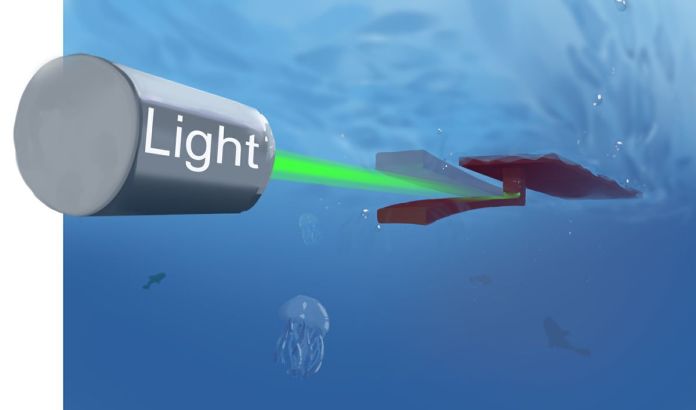
The robotics industry has advanced tremendously in recent years with several cutting edge developments. Now, researchers have created a hydrogel-based, light-powered robot that swims in response to a direct light source.
This particular robot, the OsciBot, is attracted to and only powered by a constant visible light source. It doesn’t require a battery pack or power tether of any kind. This type of technology could revolutionise the maritime industry in terms of energy harvesting and propulsion in the future.
Oscillations Explained
As stated in a report from ScienceRobotics, this soft phototactic swimmer works on a self-sustaining hydrogel oscillator. Oscillations are prominent in living organisms where it generates propulsion-based movement through constant ambient conditions. This includes phototactic movement which could help take robotics to the next level with autonomous, remotely steered robots.
The majority of man-made oscillations requires an energy source and cannot perform any movement dictated by the environment. This brings us to OsciBot, a self-sustained soft oscillator providing perpetual and untethered movement. Constant visible light is the only fuel that this swimming robot requires to move and steer remotely.
Robotics At The Highest Level
Researchers from the UCLA Samueli School of Engineering are responsible for this fascinating robotics innovation. To demonstrate their incredible feat, they managed to move OsciBot around a bend by simply changing the light source position.
According to a press release, “OsciBot demonstrates that moving by oscillation can be directly powered [by] constant light, rather than relying on light energy that has been harvested and stored in a battery. It’s made entirely of a soft material called a hydrogel that swells when placed in water and is responsive to light.”
Inspiration for this robot came from a natural phenomenon called phototaxis as various creatures in nature move towards a light source including jellyfish and moths. This new design could have interesting applications in the near future especially for ocean-going robots, medical treatments and autonomous ships.
Making The OsciBot Move
First, they had to develop a way to make an object oscillate in response to a constant energy source. To accomplish that, the team built a 2 cm flexible hydrogel cylinder which they anchored to the bottom of a water tank.
The result was astonishing as the cylinder moved about 66 times per minute when they directed a beam of light at it. Another interesting finding was that the cylinder would bend left, right, up or down when moving the light source.
Even more interesting was the speed at which the cylinder moved when they changed the length and thickness of the cylinder. Based on these results, the team built a surfboard-shaped robot using the same hydrogel. It had an extended underwater tail which is clearly visible in the video below.
Infinite Movement From Nature Itself
As stated in the UCLA press release, “When light from a laser hits a spot on the tail, that spot heats up. The slight increase in temperature causes that part of the robot to eject some of its water and shrink in volume, which moves the tail toward the light source. After it moves up, the tail creates a shadow that cools the section where the laser originally made contact with the robot, which causes the tail to descend again.“
To summarise then; as long as the light source continuously hits the target, this process can be repeated infinitely. After doing a few more experiments, they made the tail flap about 35 times per minute. According to their calculations, this would move the robot 1.15 times its body length every minute. That’s a substantial distance in movement when you consider the power source is simply direct light.
Applications Of Light-Powered Robotics
Yusen Zhao, the lead author of the study, believes that “It could be a step toward a variety of robotic designs that are untethered and powered solely by the available light in their surroundings, rather than relying on heavy batteries or power cables.“
A scaled design could offer new underwater propulsion systems and perhaps applications for wind sails using sunlight to move around. Taking it down a notch, this technology could also be used in precision medical procedures but it would require introducing a direct light source into the patient’s body.
Final Thoughts
If you consider how far we’ve come in the last 5 – 10 years, nothing seems impossible anymore. The future of robotics looks promising in every way and across various sectors. We could further adapt this technology to generate energy in the form of acoustic waves or electronic/magnetic signals.
In closing, Zhao said the following: “The beauty of the gel-based photo-oscillator is its design simplicity. The interplay between the ‘smart’ soft material and the environmental light enabled its self-regulated motion.”
If you liked reading this article, please follow our blog for all the latest news in manufacturing, engineering and technology. Speaking of technology and robotics, you should also read our article about How Robots Could Shape The Oil & Gas Industry.
This site uses Akismet to reduce spam. Learn how your comment data is processed.


 Mail:
Mail: 





Leave a Comments